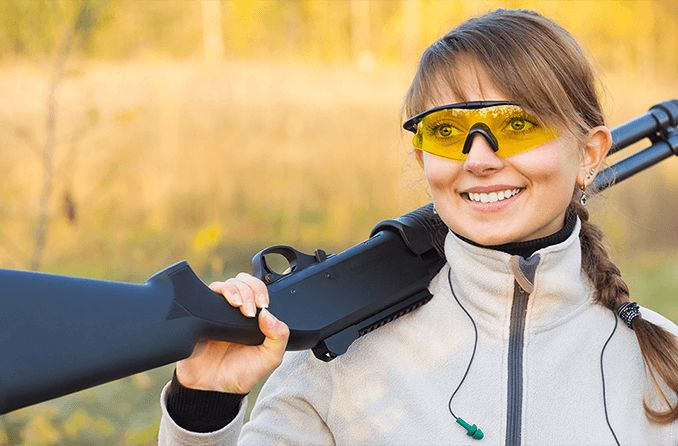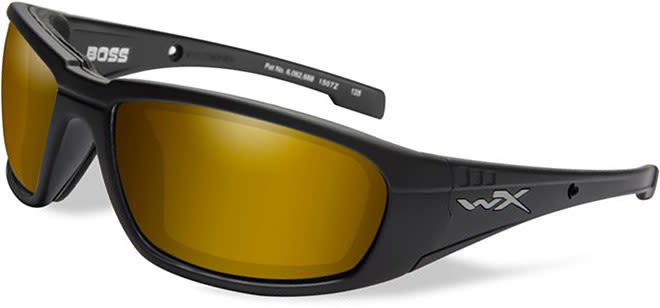Shooting glasses and hunting eyewear

Eye protection is essential for anyone using a firearm, whether at a shooting range or in a forest or field.
All firearms have a certain amount of recoil, and many shooting activities take place outdoors where wind, sun and dust also can lead to eye and vision problems.
Shotguns and rifles are held on the shoulder, while handguns are no more than an arm's length away. These different shooting activities occur in close proximity to the face, which means you should take every precaution to shield your eyes from harm.
Good eye protection makes sense and often is required during organized matches or while shooting on a range. Some rangemasters allow shooters to wear any kind of eyewear they like, but sometimes certain safety standards are required.

Wiley X Boss shooting glasses have a variety of lens color options, including clear. Shown are Venice gold mirror polarized lenses, designed for sunny conditions, in shatterproof polycarbonate. The frame can accept prescription lenses as well.
Generic, contoured nonprescription sports goggles are acceptable if you don't require vision correction or if you wear contact lenses. These goggles have a slight wrap around the face and keep out wind and dust.
If you need prescription shooting glasses in order to see clearly, or if you simply want to use the best shooting eyewear available, shooting glasses in styles similar to aviator sunglasses tend to be popular.
Eyewear designed for shooters, however, has a few more features to make you more comfortable while using a firearm:
The frame styles generally have a "sweat bar" that runs the width of the frame above the lenses to add stability to the frame for a secure fit.
The frames also are made in a rounded shape, to avoid sharp corners that could jab your face.
Some brands have special padding on the frame around the eyes. The padding cushions the frame against your face in case the gun recoils too far. This also helps to keep out wind and dust.
Additional Frame Features In Shooting Glasses
The temples of shooting glasses often are designed with spring hinges that allow the frame to flex without breaking when recoil occurs. Temples also wrap around the ear in the "cable" style to help keep the frame in place, and the tips of the temples may feature rounded ends to enhance comfort.
Nose pads are adjustable so that the frame rests in the optimum position, and soft silicone pads often are used for additional comfort.
Some shooting glasses feature bridges that adjust to one of several locking positions so that the glasses are positioned just right for any shot. The frames are constructed of any number of ophthalmic materials, including titanium and other metals, regular plastic and tough polycarbonate.
The Best Lenses For Shooting Glasses
Polycarbonate lenses with a scratch-resistant hard coat and built-in ultraviolet protection have been the lenses of choice for shooting glasses for many years. This lens material is highly impact-resistant to provide you with maximum "blow-back" and "bounce-back" protection.
Many nonprescription shooting glasses come with several pairs of interchangeable lenses for use under different lighting and atmospheric conditions. Prescription lenses can be made to order in whatever color you deem most appropriate. Ask your optician for details.
Lens tints also can be a factor in the performance of shooting glasses. Many shooters are comfortable in lenses that are yellow or orange. Lenses in these hues block haze and blue light and usually enhance the contrast between the target and its background. The brighter yellow the lens color is, the better it is for use in low contrast and near-dark conditions.
Gray is a neutral, or "true," color that lets you see all colors as they are. Gray shooting lenses do not enhance the target, but they reduce glare in bright sunlight.
Polarized shooting lenses can be made in almost any color. Polarized lenses reduce glare caused by light reflecting off water and other flat surfaces, so outdoor vision is enhanced.
Another excellent option is photochromic lenses. These light-sensitive lenses darken automatically in response to sunlight and are available in a variety of colors, including contract-enhancing brown, neutral gray and green.
Whatever lens color you choose for your shooting glasses, consider having anti-reflective (AR) coating applied to the back surface of the lenses. This eliminates potential glare from light reflecting off the back of your lenses when the sun is behind you.
SEE RELATED: Sports Eye Safety Month
Page published on Wednesday, February 27, 2019






